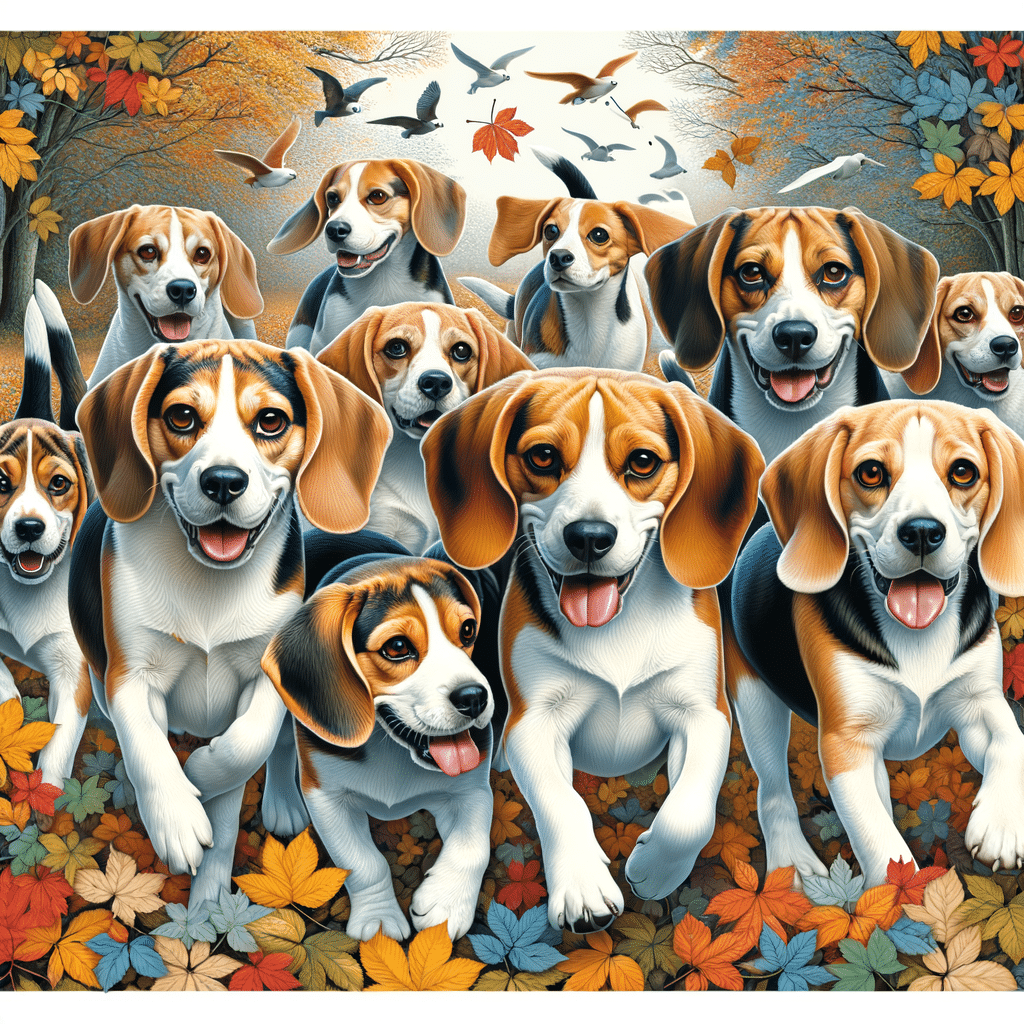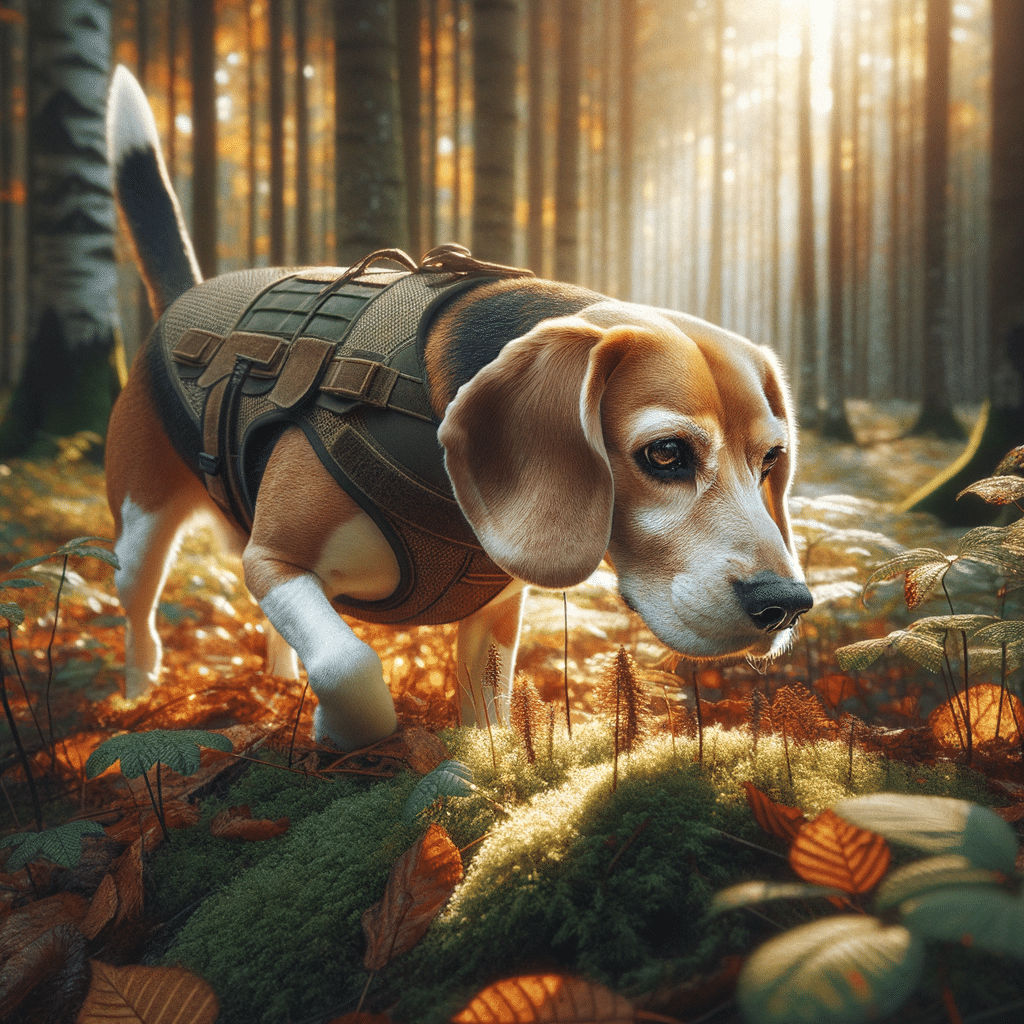Miniature beagle dogs, often called the “pocket beagle” or “teacup beagle,” are smaller versions of the standard beagle, a breed renowned for its keen sense of smell and tracking ability. Small beagles have existed for centuries, with stories indicating small beagle-like dogs existing as far back as Queen Elizabeth I’s reign. Today’s miniaturized versions maintain many of the same traits and appearances as their larger counterparts. Still, they are bred to fit a small dog lifestyle.
In This Article
Creating this tiny dog breed involves outcrossing with smaller breeds, introducing the dwarfism gene, or selectively breeding smaller beagles consistently over generations. This selective breeding aims to take the endearing qualities of the standard beagle and package them in a more petite frame that suits people who may prefer a more compact pet. Despite their size, pocket beagles still boast a playful and energetic personality that thrives on companionship, stimulus, and exercise.
Highlights
- The Queen Elizabeth pocket beagle is a miniature version of the standard beagle, historically recognized since the era of Queen Elizabeth I.
- Despite their diminutive stature, they retain the standard beagle's traits and temperament.
- Careful breeding methods and maintenance of health, behavior, and training standards are crucial for the well-being of this miniaturized breed.
Breed Overview
The miniature beagle, commonly called a pocket beagle, is a compact version of the purebred beagle, resembling a smaller foxhound. It is recognized for its distinctive traits and rich history, which dates back to medieval times.
Distinctive Traits
- Size: The pocket beagle typically stands between 7 and 12 inches tall and weighs approximately 7 to 15 pounds, similar to the size of a beagle puppy.
- Coat: It sports a short, smooth, straight coat that thickens in colder climates. Coat colors range from classic tricolor to red, white, and lemon shades.
- Appearance: The pocket beagle has characteristic large eyes and long drop ears framing faces with an expressive and beseeching look.
History and Origin
- Medieval roots: In medieval times, the miniature beagle's lineage can be traced to small hunting hounds, such as the Talbot hound. They were favored by hunters for their size and agility.
- Royal connection: These dogs were so small that they were said to be carried in gloves or pockets, leading to the term "pocket beagle." Queen Elizabeth I was known to have a fondness for miniature beagles.
- Miniature foxhounds: The miniature beagle was bred down in size from the larger beagles and inherited the appearance of a miniature foxhound.
- American Kennel Club (AKC): While the AKC recognizes the standard beagle, it does not officially recognize the miniature or pocket beagle.
Health and Care
Proper health care is essential for pocket beagle well-being and health. Attention must be given to common health issues, ensuring appropriate grooming and maintenance and meeting their exercise requirements.
Common Health Issues
Miniature beagles can be prone to specific health problems. These include:
- Obesity: Keeping them at an ideal weight is crucial for their overall health.
- Epilepsy: They may experience seizures that require veterinary attention.
- Hypothyroidism: A condition that can lead to other issues such as obesity.
- Cherry Eye: A noticeable eye condition that may necessitate surgical treatment.
Some may also be at risk of beagle health problems such as hip dysplasia or luxating patella, which affect their mobility, and less commonly, heart disease or dwarfism. Regular vet visits are mandatory to monitor and address these concerns.
Grooming and Maintenance
Miniature beagles require regular grooming to maintain their coat and overall hygiene.
- Ears: Clean their ears regularly to prevent infections due to their floppy nature.
- Nails: Trim the nails routinely to avoid discomfort and potential walking issues.
- Teeth: Brush their teeth frequently to prevent dental diseases affecting overall health.
Establishing a grooming routine early on is advised to keep them comfortable and healthy.
Exercise Requirements
These energetic dogs need daily physical activity to prevent obesity and maintain their health:
- Daily exercise: A mix of walks and playtime to meet their energy levels.
- Mental stimulation: Interactive toys and training can help keep their minds sharp and engaged.
A balance between exercise and rest is vital to a healthy, happy miniature beagle.
Behavior and Training
When considering the behavior and training of miniature beagle dogs, it is important to note their inherently friendly and playful temperament. Effective training strategies can help harness these traits into positive behaviors.
Temperament
Miniature beagles are known for their friendly and pleasant nature. They typically enjoy the company of people and other dogs, often displaying a playful demeanor. Consistent engagement and exposure to various social scenarios are crucial for their mental stimulation and well-being.
Training Strategies
Positive reinforcement is critical to train a miniature beagle effectively. These dogs respond well to:
- Food rewards: Incorporating treats to reward good behavior.
- Obedience training: Establishing basic commands early on.
- Leash training: Teaching them to walk without pulling.
- Exercise: Engaging in regular physical activity to manage energy levels.
Providing ample mental stimulation through interactive play and training exercises can prevent unwanted behaviors. The goal is to establish clear communication and strengthen obedience, leveraging their innate intelligence and eagerness to please.
Adoption and Breeders
When considering adding a miniature beagle to one’s family, it is essential to distinguish between adopting from a shelter and purchasing from a beagle breeder. Each avenue is unique regarding cost, pedigree, and the dog’s past experiences.
Choosing the Right Dog
When seeking a miniature beagle, prospective owners should evaluate whether a breeder or adoption is better suited for their household. Reputable beagle breeders provide transparency about the beagle dog breed’s lineage, health screenings, and temperament, which can be crucial for those requiring specific traits or wanting a family pet to excel in a predictable behavior pattern.
On the other hand, adoption from an animal shelter offers the opportunity to provide a home to a beagle puppy in need and can be more cost-effective. However, it may come with less background knowledge about the toy beagle.
No matter which route you choose, all pocket beagles share some characteristics, including:
- Good with children: Miniature beagles are known for their affectionate nature and can make excellent family pets.
- Activity needs: These pocket beagle puppies require regular exercise and mental stimulation.
Mini Beagle Adoption
Adopting a pocket beagle typically involves working with animal shelters or rescue groups. Organizations specializing in beagle rescue can help match a dog with suitable owners, ensuring a good fit for the pet and the family. The price of adoption varies but generally includes vaccination, spay/neuter, and sometimes a microchip, making it a cost-conscious option compared to purchasing a puppy from a breeder.
Things to consider include:
- Price range: Adoption fees can range from nominal to several hundred dollars.
- Support after adoption: Many shelters offer post-adoption support for new owners as they integrate mini beagles into their homes.
Frequently Asked Questions
This section addresses common inquiries about miniature beagles, providing essential details for individuals interested in this smaller variant of the traditional beagle breed.
What are the distinctive characteristics of a pocket beagle versus a standard beagle?
Pocket beagles are notably smaller than standard beagles, typically around 13 inches or less. They also weigh less, often between 15 and 18 pounds, whereas standard beagles can be larger and heavier.
How large can a mini beagle grow, and what are its full-grown dimensions?
A mini beagle can grow up to 13 inches in height and often reaches its total size by the age of 1 year. Its proportions are similar to those of its standard beagle counterparts but on a reduced scale.
Where can one find miniature beagle puppies available for adoption?
Miniature beagle puppies may be adopted through specific breed rescues or shelters focusing on beagles. Prospective owners may also find them through breeders specializing in this smaller beagle variety.
What is the typical price range for a pocket beagle?
The price range for a pocket beagle can vary widely. Still, purchasers may expect to pay anywhere from several hundred to over a thousand dollars, depending on the breeder’s reputation and the dog’s pedigree.
What should potential owners know about the care requirements for miniature beagles?
Owners should know that miniature beagles require regular grooming, including bathing every few weeks. They also need daily exercise and mental stimulation to maintain their health and happiness. Owners need to be mindful of their predisposition to specific health issues.
How common are pocket beagles, and what factors contribute to their rarity?
Pocket beagles are less common than standard beagles. Their rarity can be attributed to specialized breeding practices and fewer breeders focusing on maintaining the smaller size without compromising the dog’s health and well-being.






